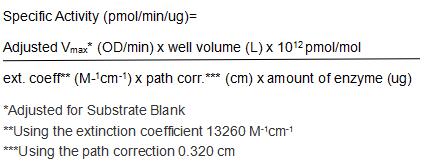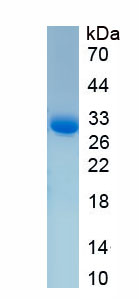Active Granzyme H (GZMH) 

CCP-X; CGL-2; CSP-C; CTLA1; CTSGL2; Cathepsin G-Like 2,Protein h-CCPX; Cytotoxic T-lymphocyte proteinase; Cytotoxic serine protease C
- UOM
- FOB US$ 268.00 US$ 670.00 US$ 1,340.00 US$ 4,020.00 US$ 10,050.00
- Quantity
Overview
Properties
- Product No.APL575Hu01
- Organism SpeciesHomo sapiens (Human) Same name, Different species.
- ApplicationsCell culture; Activity Assays.
Research use only - DownloadInstruction Manual
- CategoryEnzyme & Kinase
- Buffer FormulationPBS, pH7.4, containing 0.01% SKL, 5% Trehalose.
- Traits Freeze-dried powder, Purity > 95%
- Isoelectric Point9.9
Sign into your account
Share a new citation as an author
Upload your experimental result
Review

Contact us
Please fill in the blank.
Activity test

Granzyme H is a member of the granzyme family of serine proteases found specifically in the cytotoxic granules of cytotoxic T lymphocytes (CTL) and natural killer (NK) cells. Granzyme H’s functions are largely unknown. The more abundant expression of Granzyme H than Granzyme B in NK cells suggests that Granzyme H may complement the pro-apoptotic function of Granzyme B in this cell type. Human Granzyme H is synthesized as a precursor (246 residues) with a signal peptide (residues 1-18), a propeptide (residues 19-20) and a mature chain (residues 21-246). The purified recombinant human Granzyme H consists of residues 19 to 246 which activity was measured by its ability to cleaves a thioester substrate Z-Lys-SBzl•HCl. The reaction was performed in 0.05 M Tris, 0.15 M NaCl, 0.01% Triton X-100, pH 8.0 (Assay Buffer), initiated by addition 50 μL of various concentrations of GZMH (diluted by Assay Buffer) to 50 µL of 1.2 mM Substrate and DTNB mixture. The final well serves as a negative control with no GZMH, replaced with 50 μL assay buffer. Incubated at 25℃ for 5min, then read at a wavelength of 405 nm. The specific activity of recombinant human Granzyme H is >300 pmol/min/µg.
Usage
Reconstitute in 10mM PBS (pH7.4) to a concentration of 0.1-1.0 mg/mL. Do not vortex.
Storage
Avoid repeated freeze/thaw cycles. Store at 2-8°C for one month. Aliquot and store at -80°C for 12 months.
Stability
The thermal stability is described by the loss rate. The loss rate was determined by accelerated thermal degradation test, that is, incubate the protein at 37°C for 48h, and no obvious degradation and precipitation were observed. The loss rate is less than 5% within the expiration date under appropriate storage condition.
Increment services
-
 BCA Protein Quantification Kit
BCA Protein Quantification Kit
-
 Molecular Mass Marker for Protein
Molecular Mass Marker for Protein
-
 Monoclonal Antibody Customized Service
Monoclonal Antibody Customized Service
-
 Polyclonal Antibody Customized Service
Polyclonal Antibody Customized Service
-
 Protein Activity Test Experiment Service
Protein Activity Test Experiment Service
-
 Electrophoretic Mobility Shift Assay (EMSA) Experiment Service
Electrophoretic Mobility Shift Assay (EMSA) Experiment Service
-
 Buffer
Buffer
-
 Lentivirus Packaging Experiment Service
Lentivirus Packaging Experiment Service
-
 Adenovirus Packaging Experiment Service
Adenovirus Packaging Experiment Service
-
 Real Time PCR Experimental Service
Real Time PCR Experimental Service
-
 Spike RBD Protein (S-RBD)
Spike RBD Protein (S-RBD)
-
 Protein G
Protein G
-
 Protein A
Protein A







